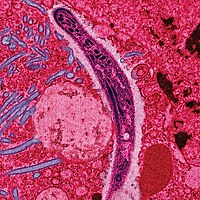
Cooperative Metabolic Adaptations in the Host Can Favor Asymptomatic Infection and Select for Attenuated Virulence in an Enteric Pathogen
Sign Up to like & getrecommendations! Published in 2018 at "Cell"
DOI: 10.1016/j.cell.2018.07.016
Abstract: Pathogen virulence exists on a continuum. The strategies that drive symptomatic or asymptomatic infections remain largely unknown. We took advantage of the concept of lethal dose 50 (LD50) to ask which component of individual non-genetic variation… read more here.
Keywords: dietary iron; pathogen; cooperative metabolic; virulence ... See more keywords

Associations between enteric pathogen carriage and height-for-age, weight-for-age and weight-for-height in children under 5 years old in urban Dhaka, Bangladesh
Sign Up to like & getrecommendations! Published in 2020 at "Epidemiology and Infection"
DOI: 10.1017/s0950268820000369
Abstract: Abstract Nutritional factors and infectious agents may contribute to paediatric growth deficits in low- and middle-income countries; however, the contribution of enteric pathogens is only beginning to be understood. We analysed the stool from children read more here.
Keywords: children years; enteric pathogen; age weight; years old ... See more keywords

Study design and rationale for the PAASIM project: a matched cohort study on urban water supply improvements and infant enteric pathogen infection, gut microbiome development and health in Mozambique
Sign Up to like & getrecommendations! Published in 2022 at "BMJ Open"
DOI: 10.1136/bmjopen-2022-067341
Abstract: Introduction Despite clear linkages between provision of clean water and improvements in child health, limited information exists about the health impacts of large water infrastructure improvements in low-income settings. Billions of dollars are spent annually… read more here.
Keywords: health; water; study; water supply ... See more keywords

Enteric pathogen infection and consequences for child growth in young Aboriginal Australian children: a cross-sectional study
Sign Up to like & getrecommendations! Published in 2021 at "BMC Infectious Diseases"
DOI: 10.1186/s12879-020-05685-1
Abstract: Background To determine the prevalence of enteric infections in Aboriginal children aged 0–2 years using conventional and molecular diagnostic techniques and to explore associations between the presence of pathogens and child growth. Methods Cross-sectional analysis of… read more here.
Keywords: cross sectional; infection; enteric pathogen; child growth ... See more keywords

Stool biomarkers as measures of enteric pathogen infection in infants from Addis Ababa informal settlements
Sign Up to like & getrecommendations! Published in 2023 at "PLOS Neglected Tropical Diseases"
DOI: 10.1371/journal.pntd.0011112
Abstract: Frequent enteric infections in children may be an important cause of growth faltering; however, we do not fully understand the mechanisms by which pathogen infections and the physiological responses to these infections result in poorer… read more here.
Keywords: pathogen; pathogen infection; infection; informal settlements ... See more keywords

Muc2-dependent microbial colonization of the jejunal mucus layer is diet sensitive and confers local resistance to enteric pathogen infection.
Sign Up to like & getrecommendations! Published in 2023 at "Cell reports"
DOI: 10.2139/ssrn.3931635
Abstract: Intestinal mucus barriers normally prevent microbial infections but are sensitive to diet-dependent changes in the luminal environment. Here we demonstrate that mice fed a Western-style diet (WSD) suffer regiospecific failure of the mucus barrier in… read more here.
Keywords: colonization; jejunal mucus; mucus; mucus layer ... See more keywords

Cathelicidin-related antimicrobial peptide protects against enteric pathogen-accelerated type 1 diabetes in mice
Sign Up to like & getrecommendations! Published in 2022 at "Theranostics"
DOI: 10.7150/thno.61433
Abstract: Rationale: Gut barrier disruption caused by enteric pathogen infection results in activated diabetogenic T cells and accelerated type 1 diabetes (T1D). Cathelicidin-related antimicrobial peptide (CRAMP) maintains intestinal barrier integrity, regulates the microbiome, and exerts positive… read more here.
Keywords: gut; cramp; rodentium; gut barrier ... See more keywords